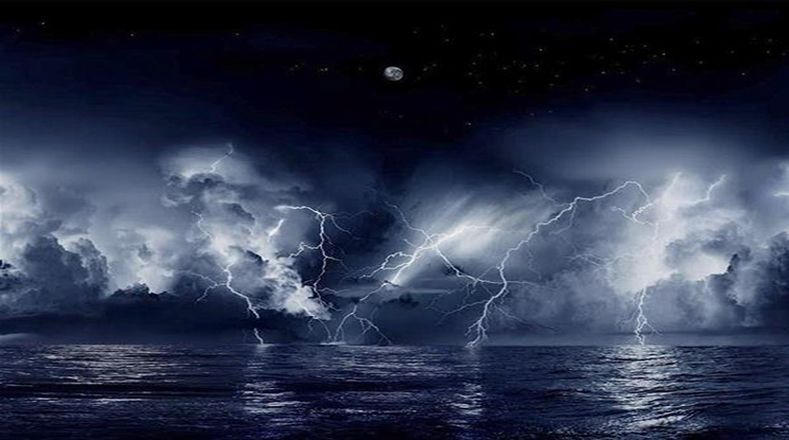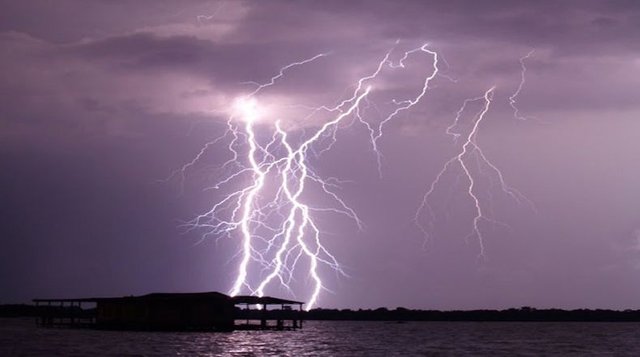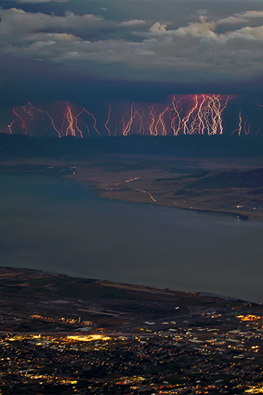The Lightning of the Catatumbo, the eternal storm of Venezuela
As we have been warning since the beginning of 2010, by the way decreed in the Assembly of the United Nations (UN) as "International Year of Biodiversity" or Biodiversity, the loss of thousands of hectares consumed by not controlling in time devastating fire fires, the drought that has diminished hydrographic basins that feed and make our Lake Maracaibo an important estuary in South America and the Caribbean.
Deforestation had already done its part and not to mention the great damage to the heritage with immeasurable environmental and ecological consequences or impacts resulting from the extraction of coal. The lack of attention to wetlands, mangroves, swamps and the entire biome that represents the South of the Lake in general. Of course I had to somehow hand in hand with the imminent climate change, which affected the conditions for the most interesting climate phenomenon generated, unique in its condition, as is the CATATUMBO LIGHTNING.
It owes its name to the Catatumbo River, which represents more than half of the water that enters the Lake of Maracaibo, it can be said that this lake is really that river and that the others of the basin fall. This is a little intervened area, although there is oil exploitation and agricultural activity in both Colombia and Venezuela provide nitrogenous and toxic salts, which weakens the life of the lake.
In that sector of the Jesús María Semprún Municipality, an extensive area is created, bathed by Padre Río Catatumbo (this is how the thunder sounds), the lightning rising as a beacon that guides the navigators, walkers and riders of the region.
Only the island of Java competes in the almost daily continuity of the appearance of lightning, but the area of Father Rio Catatumbo is a record for being every day of the year and several times a day. "According to the Nitrogen Cycle has to go through this phenomenon and the creation of atmospheric ozone (the blue of the sky) also gets origin in it, so it can be said that Father Catatumbo River Lightning nourishes our floors and paints blue to our planet "(Words by Elio Ríos, Environmentalist and Founder of Azul Ambientalistas).

Studies
The first writing mentioning Catatumbo's lightning bolt was the epic poem "La Dragontea" by Lope de Vega, published in 1597, which recounts the defeat of the English pirate Francis Drake by the mayor of Nombre de Dios, Diego Suárez de Amaya. The Prussian naturalist and explorer Alejandro de Humboldt described it as "electric explosions that are like phosphorescent glares ..."; It was later reviewed by the Italian geographer Agustín Codazzi as a "continuous lightning that seems to emerge from the Zulia river and its surroundings".
Among the main modern studies is the one by Melchor Centeno, who attributes the origin of electrical storms to the closed circulation of winds in the region.
Between 1966 and 1970, the scientist Andrés Zavratsky together with assistants of the University of the Andes, made three expeditions, to Santa Bárbara del Zulia, with which he concluded that the location would have several epicenters in the swamps of the Ciénagas National Park of Juan Manuel de Aguas Claras and Aguas Negras west of Lake Maracaibo; without penetrating them. And it suggests in 1991 that the phenomenon occurs due to the encounter of cold and hot air currents without discarding uranium as a possible cocaine agent, although this last fact is nothing more than mere speculation. Additionally, it is worth considering the contribution of the Hydrometeorologist Julio Lescarboura Sola who, in his thesis and subsequent studies throughout his life, made considerable contributions to the study and probable origin of this phenomenon.

Between 1997 and 2000, a team headed by Nelson Falcón from the University of Carabobo carried out several expeditions and managed to locate the epicenters of the phenomenon inside the Ciénagas de Juan Manuel, and made the first microphysical model of the Catatumbo lightning, identifying the methane as one of the main causes of the phenomenon, although it is also a general model of cloud electrification; Still to be confirmed with accurate measurements inside the clouds of lightning. Methane also appears to be associated with the lightning bolts of Titan (Saturn's satellite) and appears linked to other areas of great electroatmospheric activity, such as southern Florida and central Africa. According to this model, methane comes not only from the swamps of the south of the lake but also from fissures in the rocky mantle, rich in kerogen III, a product associated with large deposits of light hydrocarbons, common in the Maracaibo lake basin. Unlike other hypotheses, this is a quantitative model with a focus on the physics of observed discharges; it is a theory and not a mere conjecture about "collisions" of cold and hot air fronts that would explain the rainfall but not the permanent and unusual electrical activity observed.
Location
It can be observed that, although almost all of Venezuela is cloudless, the southwest of Lake Maracaibo, as well as the region also southwest of the state of Zulia itself, are covered with clouds. The tropical depression east of Venezuela with a 30% chance of becoming a tropical storm soon became Hurricane Rafael.
The Catatumbo lightning is usually developed between the coordinates of 8º 30 'and 9º 45' north latitude and 71º and 73º west longitude, which is a very large area although, as is logical, not all of this area always has the same stormy activity. The most remote areas of this extensive area are occupied by Motilon indigenous groups, who always tenaciously resisted the domination by the Spaniards first and those who tried to exploit their territory later. And it was very recently when they accepted the participation of Spanish Capuchin missionaries (already in the second half of the 20th century), who founded several mission towns such as El Tukuko and others. In El Tukuko a simple meteorological station was installed and in several years of observation the annual rainfall never dropped below 4,000 mm, which serves to give an example of the raininess of the area. In turn, this also explains the great flow of the Catatumbo River, which, with some 500 km in length, is navigable over a large part of its route. The final part of its course has numerous meanders and delivers to the lake of Maracaibo an enormous amount of sediments, ending in a delta that has been built in the lake itself. In fact, if it were not for the fact that the lake constitutes a zone of land subsidence (that is, a sedimentary or subsidence basin), the sediments contributed by the river have long covered the lake completely.

Social and tourism impact
Catatumbo lightning is admired by Venezuelan society, especially in the northwestern state of Zulia, which has a lightning bolt on its official shield to symbolize the phenomenon. Also the letter of the anthem of the Zulia State, whose author is the Zuliano Udón Pérez, includes a stanza that makes reference to this phenomenon:
"The light with which the lightning / tenacious of the Catatumbo / of the nauta fixes the course / which limpid lantern"
The wari ethnic group defines it as "the concentration of millions of cocuyos (fireflies) that meet every night in the Catatumbo to pay tribute to the fathers of creation", while the yucpas and the Wayúu attribute it to the presence of the spirits of the fallen guajiros that shine as a kind of message, besides considering it the "eternal radiance in the heights".
A Zulian bagpipe (in addition to many other songs and works) refers to the Catatumbo phenomenon:
A bagpipe around the world / is a message of love / and the ray of Catatumbo / gives light with its glare
The Super Combo Los Tropicales, in its baseball theme "La Pelota Caliente", also mentions "the thunder" of Catatumbo:
The power of the black gold / and the thunder of the Catatumbo / will make new paths / to the Zulian Eagles.
Among the main historical curiosities is a story about the attempt of Francis Drake in 1595 to loot Maracaibo, which was frustrated by the early warning to the garrison of the city, produced thanks to the lighting of the lightning. In addition, during the war of independence, the lightning served as a beacon for the naval force of Admiral José Prudencio Padilla, who managed to defeat the Spanish ships on July 24, 1823.
Congratulations @lucyvalera! You have completed some achievement on Steemit and have been rewarded with new badge(s) :
Click on any badge to view your own Board of Honor on SteemitBoard.
For more information about SteemitBoard, click here
If you no longer want to receive notifications, reply to this comment with the word
STOP